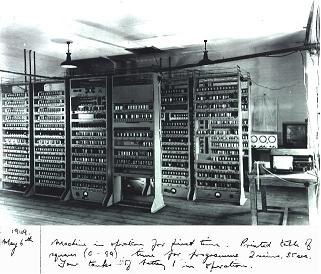Behind the green door
Duration: 19 mins 51 secs
Share this media item:
Embed this media item:
Embed this media item:
About this item

| Description: | In 1947, Maurice Wilkes was joined at the Mathematical Laboratory by Eric Mutch from TRE Malvern and Philip Farmer. Also came Bill Renwick, a design engineer who had worked on radar for the Royal Navy. These four then began to recruit a team of engineers to build the EDSAC. Some of these early pioneers describe working to introduce computing to the world. |
|---|
| Created: | 2010-04-13 12:48 |
|---|---|
| Collection: | EDSAC 99 |
| Publisher: | University of Cambridge |
| Copyright: | Computer Laboratory |
| Language: | eng (English) |
| Keywords: | EDSAC; engineers; |
| Abstract: | Components for EDSAC were purchased either through ordinary trade channels or from a Government store that the Laboratory was allowed to use. The valves were a gift from the Ministry of Supply of (unused) surplus stock. However, much local adaptation and ingenuity was required. Gordon Stevens built the first paper-tape reader. Paper-tape punches and printers were obtained, but had to be modified to work on EDSAC.
All the engineers wore white coats, a necessary precaution. Fault finding was very much a hit and miss affair in those early days, with the only diagnostic instruments being an Avometer and a fairly primitive oscilloscope. Valves were changed sequentially until the faulty one was located. Ten of these pioneers recount life in the early days. Gordon Stevens came from Unicam Instrument Co. as the Lab’s first Scientific Instrument Maker in 1947. In 1949 he became Senior Assistant looking after accounts and generally anything that needed attention. Retired in 1982. Richard Kimpton started at the Mathematical Laboratory straight from school in September 1948 as a lab assistant. Worked on EDSAC 1 and after returning from National Service in 1954, did all the backwiring on EDSAC 2 in the next 12 months. Constructed peripherals for Titan and the prototype page for CAP. Retired in 1998. Herbert Norris joined the Lab from Engineering in 1950 as an Instrument Maker to assist Gordon Stevens. Left in 1965 to take up a teaching post at the Manor School. Now retired. Ivor Reynolds started straight from school in 1950 as a junior lab assistant. He was involved in building several prototype experimental circuits. He left to work for De Havilland Propellors in 1958/59, but returned in 1960 for a year to design Chassis 3 for EDSAC 2. Then went to British Aerospace. Retired in July 1993. Vic Claydon joined Maths Lab from Engineering in 1951 as an Instrument Maker. Worked on both EDSAC 1 and 2. Then headed the team of Mechanical Engineers working on Titan, maintaining all the peripheral equipment. Was involved in the early days of the Hardware Maintenance Service. Retired in 1982. Ken Cox joined the Lab in December 1958 from Pye, to work as a Maintenance Engineer on EDSAC 2. Moved to Titan in 1968. Set up the Hardware Maintenance Service in 1979 and on Sid Barton’s retirement became Chief Engineer in 1982. Retired in 1993. Peter Bennett joined from Pye in March 1959 as a Maintenance Engineer for EDSAC 2. Trained to maintain the DEC PDP-7. Worked on Titan and then CAP and the Cambridge Data Ring. Retired in 1989. John Loker came from Pye in April 1959 to work on peripherals in the Tape Preparation Room. A year later joined the team of engineers on EDSAC 2. Worked on the EDSAC 2 Lineprinter with Norman Unwin. In 1966 helped to design and build the Multiplexer for Teletypes on Titan. Retired in 1998. Roy Bayley joined the Lab in 1961/62 from Marshalls to help with the commissioning of Titan, as Sid Barton’s deputy. Left in 1973 to work for the MRC Human Genetics Group in Edinburgh. Retired in the Autumn of 1995. David Prince joined the Lab in June 1963 from Jodrell Bank to work on the Tunnel Diode Slave Store for Titan. A year later joined the team of engineers first commissioning and then maintaining Titan. Worked on CAP, and then in 1979 started the Hardware Maintenance Service with Ken Cox. Appointed Chief Engineer in 1993. |
|---|---|
Available Formats
| Format | Quality | Bitrate | Size | |||
|---|---|---|---|---|---|---|
| Flash Video | 320x240 | 437.05 kbits/sec | 63.54 MB | View | Download | |
| iPod Video | 480x360 | 505.22 kbits/sec | 73.45 MB | View | Download | |
| QuickTime (for download) | 320x240 | 230.45 kbits/sec | 33.50 MB | View | Download | |
| QuickTime (for streaming) | 480x360 | 446.99 kbits/sec | 64.99 MB | View | Download | |
| Auto * | (Allows browser to choose a format it supports) | |||||

